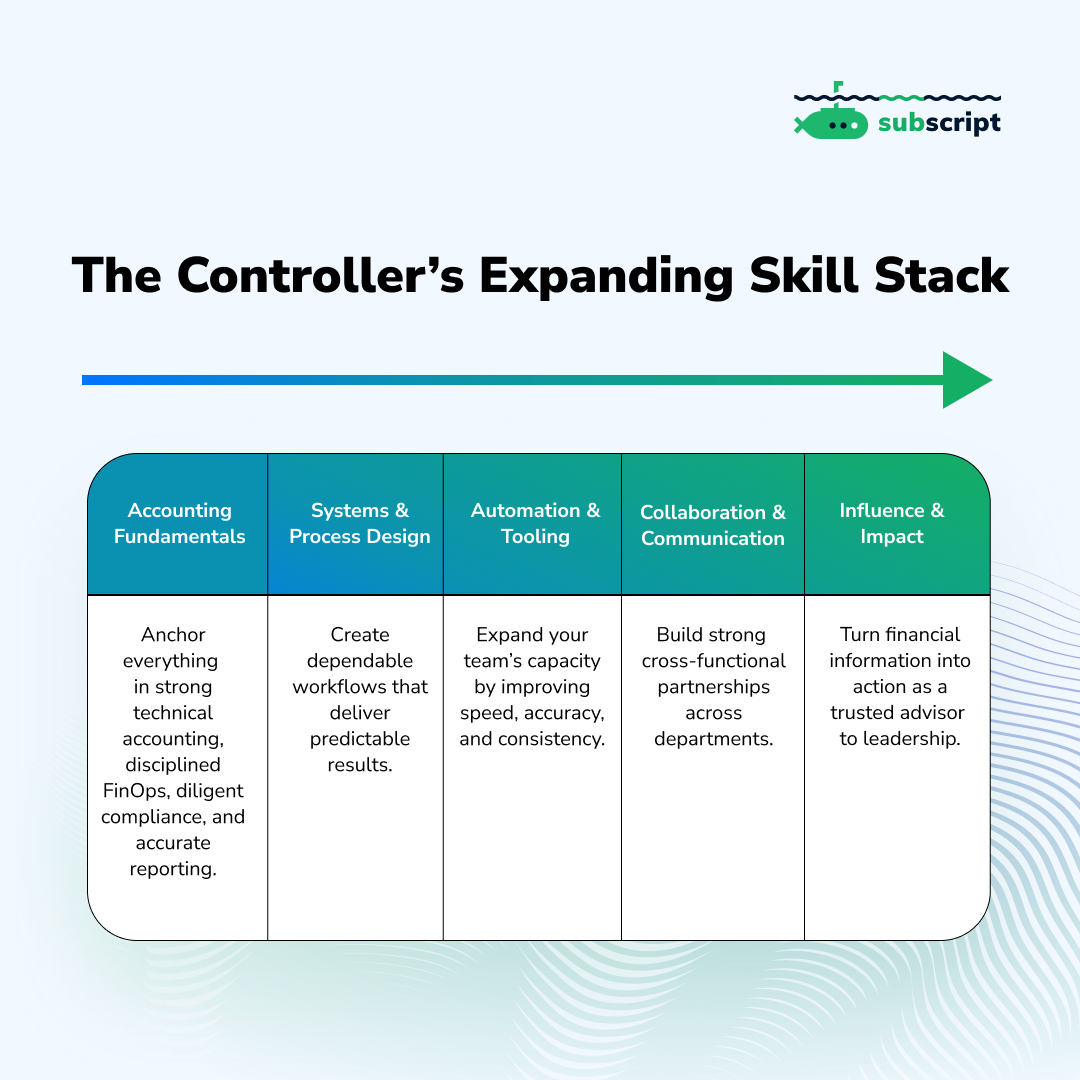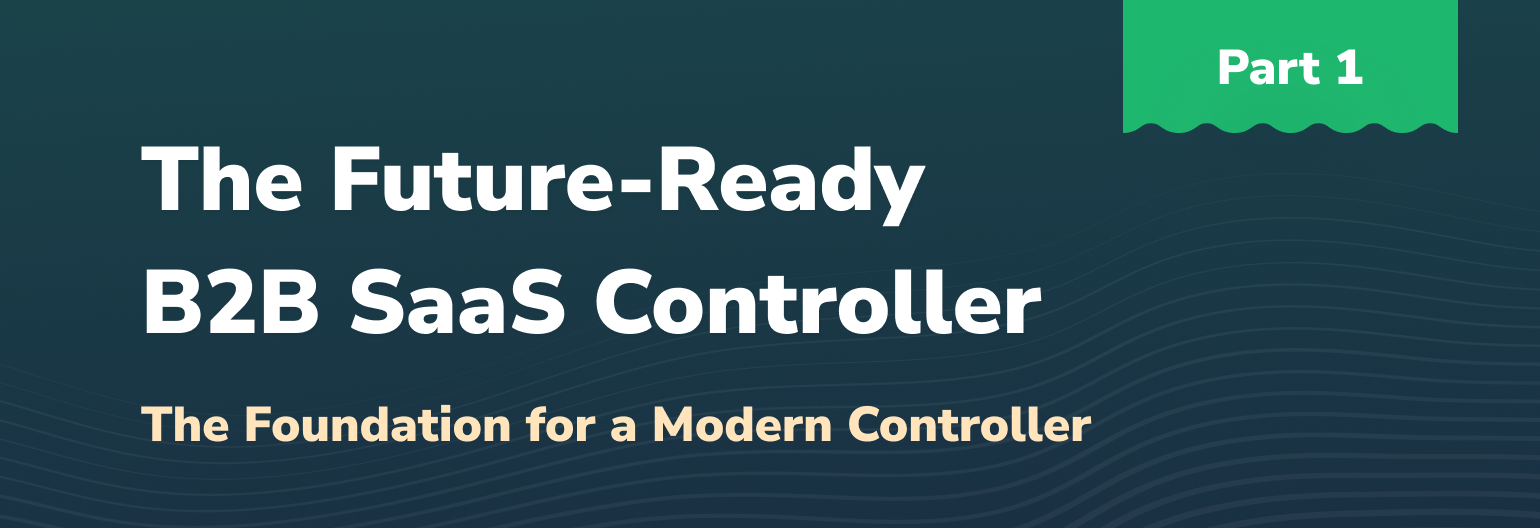The Controller’s Expanding Mandate
Controllers are responsible for decision-grade information and the processes that produce it. In B2B SaaS, that means closing accurately and on time, safeguarding cash and data, and keeping revenue workflows predictable as the business scales.
This playbook stays focused on financial operations: the workflows, controls, and decision patterns that keep billing, revenue, and reporting accurate at speed.
Why Scalability Matters
As financial tooling evolves and businesses become more complex, Controllers are increasingly evaluated not only on how fast they close, but by how effectively their processes scale.
To stay ahead, the function must be able to absorb:
- Usage-based and hybrid pricing that strain legacy systems
- Automation that shifts work from data entry to oversight
- Leadership and investor pressure for real-time reporting
- Audit scrutiny extending into system logic and control design
💡 The best Controllers pair rigor with curiosity. They protect accuracy while continuously improving how financial information flows through the business.
The Foundation for a Modern Controller
Modern controllership starts with clear command of the basics: how SaaS revenue works, how systems record it, and how those mechanics shape the company’s narrative.
Revenue fluency is the baseline. Controllers who can bridge teams, detect risks and opportunities early, and apply structured judgment help their companies stay compliant and adaptable as they scale.
1. Build Technical and Operational Fluency
Controllers are the ultimate generalists, with knowledge spanning across specialities. You don’t need deep mastery of each discipline, but you need enough context to challenge assumptions and trace data to its source.
Know how data moves through the ecosystem
- Make a living map of data flow from CRM to billing to ERP to reporting. Update it whenever ownership or integrations change.
- Test reasoning, not formatting. If something seems off, review the assumptions and supporting data.
- Develop pattern recognition through repetition. The more models and reconciliations you review, the faster you’ll sense when something doesn’t add up.
Anchor decisions in context
- Capture what data informed each decision, which assumptions drove it, and what alternatives were considered.
- Define intent before changing a process. Identify the outcome each workflow should deliver and how success will be measured.
- Keep the leadership story in view. Ensure your systems support the narrative shared with investors and employees.
Operationalize your judgment
- Balance precision with timeliness. Accuracy that lags behind decisions creates rework, confusion, and lost credibility.
- Turn recurring judgment calls into policies or configurations.
- Organize regular touchpoints with Product, RevOps, and FP&A to uncover issues before they disrupt the close.
💡 A Controller’s strength lies in connecting the dots: combining accounting logic, system behavior, and business context into decisions that scale.
2. Stay Current with Technology
Controllers who understand how their systems behave (where data originates, how it transforms, and where it fails), can manage growth and risk with confidence.
You don’t need to code, but you should think like a system designer: curious about data flow, aware of constraints, and fluent in how tools are connected.
Evaluate your finance stack first-hand
- Learn how core systems handle data models, sync frequency, and configuration limits so you can push back on “it can’t be done.”
- Track vendor roadmaps to avoid unnecessary customization that ages poorly.
- Use a sandbox for testing pricing changes, new revenue rules, and integrations without touching production data.
Develop technical intuition
- Understand how information flows through systems and where errors usually surface.
- Review logs or error reports to pinpoint issues without waiting for IT or vendors.
- Ask probing questions: What’s the source of truth? What triggers changes? What happens when inputs shift?
Monitor and test new tooling
- Track emerging tools in billing, revenue recognition, and automation. Evaluate each against clear criteria.
- Apply a consistent rubric: accuracy, scalability, integration quality, audit visibility, and vendor reliability.
- Pilot new tools in test environments before rollout, and present findings to the team for review.
💡 System fluency is a form of control. Controllers who understand their stack detect issues more reliably, adapt more quickly, and lead automation with authority.
3. Invest in Professional Education
Future-ready Controllers treat learning as part of operations: continuous, documented, and applied to real work.
Shift CPE toward applied learning
- Attend webinars and demos to stay current on capabilities and limitations, even if you don’t plan to buy.
- Capture actionable notes: the problem each tool solves, what it replaces, and what gaps remain.
- Establish a professional development budget, and encourage team members to recap their learnings in team lunch sessions.
Expand learning beyond accounting
- Borrow from other functions. Study how Engineering and RevOps drive efficiency through sprints, retrospectives, and backlogs, and adopt those methods for Finance.
- Listen to podcasts, attend conferences or bootcamps, and join professional communities to see how peers are approaching similar challenges.
- Get hands-on with SQL, Power BI, or vibe coding tools to strengthen your technical skills and solve problems more independently.
Make improvement a team habit
- Hire for curiosity and technical acumen, and reward staff for making proactive improvements, not just throughput.
- Encourage small experiments like testing new automations, querying data in new ways, or redesigning recurring reports, and note the results.
- Use post-close reviews to reflect: What worked, what slowed you down, and what to adjust in the next cycle.
💡 Continuous learning pays off. Teams that record and apply what they learn improve faster than any new hire or system.

What's Next in This Series
- Part 1. The Foundation for a Modern Controller
- Part 2. Systems Thinking & Process Optimization (coming soon)
- Part 3. Automation & AI: From Experimentation to Impact (coming soon)
- Part 4. Controller as Strategic Advisor: Metrics, Influence, and Value (coming soon)
A Modern Finance Platform Built for B2B SaaS
Scaling a SaaS business is hard enough. Don’t let your billing and revenue systems slow you down. See how flexible billing and unified revenue data can reduce manual work, accelerate close timelines, and give your team full visibility into ARR, NRR, and deferred revenue, without reconciliation headaches.
Schedule a demo today.
%20(2).svg)

.svg)
.svg)




.svg)





.svg)


.svg)







